
Illustrative Math Alignment: Grade 6 Unit 2
Introducing Ratios
Lesson 7: Creating Double Number Line Diagrams
Use the following Media4Math resources with this Illustrative Math lesson.
| Thumbnail Image | Title | Body | Curriculum Topic |
|---|---|---|---|
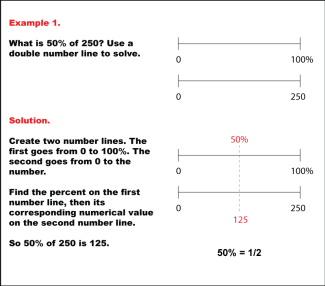
|
Math Example: Percents with Double Number Lines: Example 1 |
Math Example: Percents with Double Number Lines: Example 1TopicRatios, Proportions, Percents DescriptionThis example demonstrates how to find 50% of 250 using a double number line. The solution shows two parallel number lines: one ranging from 0 to 100% and the other from 0 to 250. By aligning 50% on the percentage line with its corresponding value on the numerical line, we can see that 50% of 250 is 125. This method visually represents the concept that 50% is equivalent to one-half of a quantity. |
Ratios and Rates |

|
Math Example: Percents with Double Number Lines: Example 10 |
Math Example: Percents with Double Number Lines: Example 10TopicRatios, Proportions, Percents DescriptionThis example demonstrates how to determine an unknown value using a double number line when given a part and its corresponding percentage, involving a decimal percentage. The image shows two number lines: one ranging from 0 to 100% and another from 0 to an unknown number x. The position 70 is marked on the second line, visually illustrating the process of finding x when 70 is 12.5% of x. |
Ratios and Rates |
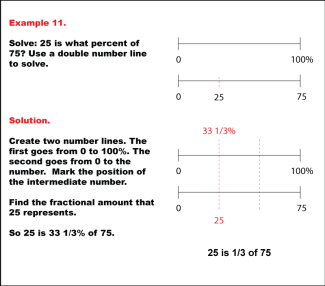
|
Math Example: Percents with Double Number Lines: Example 11 |
Math Example: Percents with Double Number Lines: Example 11TopicRatios, Proportions, Percents DescriptionThis example demonstrates how to determine what percent one number is of another using a double number line. The image shows two parallel number lines: one ranging from 0 to 100% and another from 0 to 75, with 25 marked as an intermediate point. This visual representation helps students understand the relationship between the part (25) and the whole (75) in percentage terms. |
Ratios and Rates |
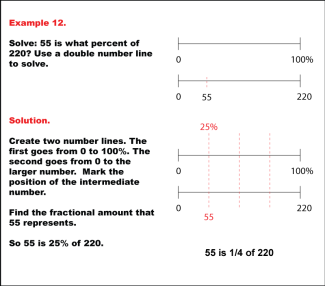
|
Math Example: Percents with Double Number Lines: Example 12 |
Math Example: Percents with Double Number Lines: Example 12TopicRatios, Proportions, Percents DescriptionThis example illustrates how to calculate what percent one number is of another using a double number line. The image depicts two parallel number lines: one spanning from 0 to 100% and another from 0 to 220, with 55 marked as an intermediate point. This visual representation helps students understand the relationship between the part (55) and the whole (220) in percentage terms. |
Ratios and Rates |
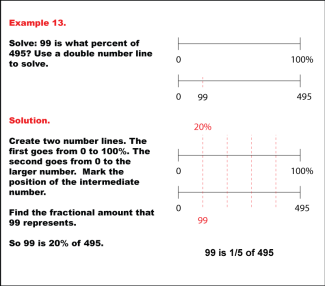
|
Math Example: Percents with Double Number Lines: Example 13 |
Math Example: Percents with Double Number Lines: Example 13TopicRatios, Proportions, Percents DescriptionThis example demonstrates how to determine what percent one number is of another using a double number line. The image shows two parallel number lines: one ranging from 0 to 100% and another from 0 to 495, with 99 marked as an intermediate point. This visual representation helps students understand the relationship between the part (99) and the whole (495) in percentage terms. |
Ratios and Rates |
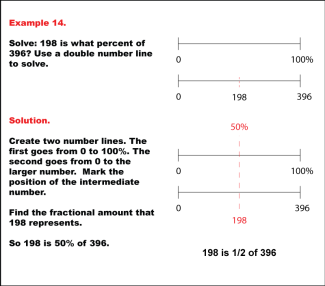
|
Math Example: Percents with Double Number Lines: Example 14 |
Math Example: Percents with Double Number Lines: Example 14TopicRatios, Proportions, Percents DescriptionThis example illustrates how to calculate what percent one number is of another using a double number line. The image depicts two parallel number lines: one spanning from 0 to 100% and another from 0 to 396, with 198 marked at the midpoint. This visual representation helps students understand the relationship between the part (198) and the whole (396) in percentage terms. |
Ratios and Rates |
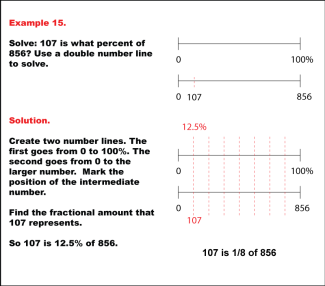
|
Math Example: Percents with Double Number Lines: Example 15 |
Math Example: Percents with Double Number Lines: Example 15TopicRatios, Proportions, Percents DescriptionThis example demonstrates how to determine what percent one number is of another using a double number line, particularly when dealing with more complex ratios. The image shows two parallel number lines: one ranging from 0 to 100% and another from 0 to 856, with 107 marked at an eighth of the way. This visual representation helps students understand the relationship between the part (107) and the whole (856) in percentage terms. |
Ratios and Rates |
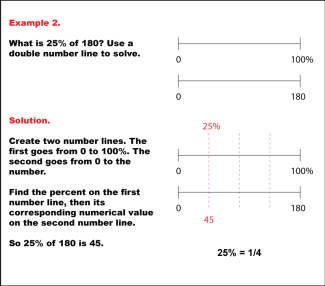
|
Math Example: Percents with Double Number Lines: Example 2 |
Math Example: Percents with Double Number Lines: Example 2TopicRatios, Proportions, Percents DescriptionThis example illustrates how to calculate 25% of 180 using a double number line. The solution presents two parallel number lines: one spanning from 0 to 100% and the other from 0 to 180. By aligning 25% on the percentage line with its corresponding value on the numerical line, we can determine that 25% of 180 is 45. This method visually demonstrates that 25% is equivalent to one-quarter of a quantity. |
Ratios and Rates |
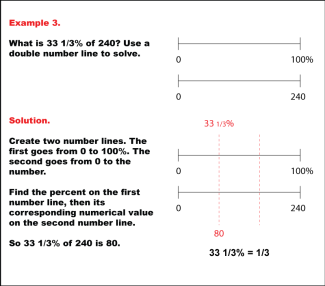
|
Math Example: Percents with Double Number Lines: Example 3 |
Math Example: Percents with Double Number Lines: Example 3TopicRatios, Proportions, Percents DescriptionThis example demonstrates how to find 33 1/3% of 240 using a double number line. The solution displays two parallel number lines: one ranging from 0 to 100% and the other from 0 to 240. By aligning 33 1/3% on the percentage line with its corresponding value on the numerical line, we can see that 33 1/3% of 240 is 80. This method visually represents the concept that 33 1/3% is equivalent to one-third of a quantity. |
Ratios and Rates |
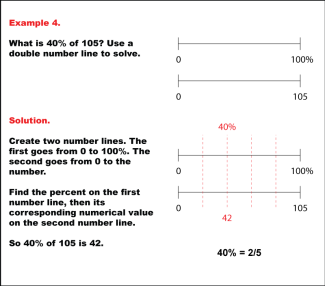
|
Math Example: Percents with Double Number Lines: Example 4 |
Math Example: Percents with Double Number Lines: Example 4TopicRatios, Proportions, Percents DescriptionThis example illustrates how to calculate 40% of 105 using a double number line. The solution presents two parallel number lines: one spanning from 0 to 100% and the other from 0 to 105. By aligning 40% on the percentage line with its corresponding value on the numerical line, we can determine that 40% of 105 is 42. This method visually demonstrates that 40% is equivalent to two-fifths of a quantity. |
Ratios and Rates |
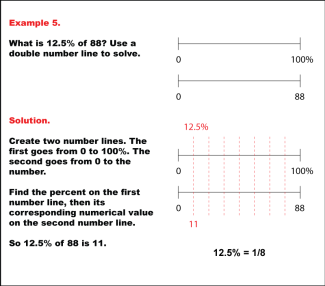
|
Math Example: Percents with Double Number Lines: Example 5 |
Math Example: Percents with Double Number Lines: Example 5TopicRatios, Proportions, Percents DescriptionThis example demonstrates how to find 12.5% of 88 using a double number line. The solution shows two parallel number lines: one ranging from 0 to 100% and the other from 0 to 88. By aligning 12.5% on the percentage line with its corresponding value on the numerical line, we can see that 12.5% of 88 is 11. This method visually represents the concept that 12.5% is equivalent to one-eighth of a quantity. |
Ratios and Rates |

|
Math Example: Percents with Double Number Lines: Example 6 |
Math Example: Percents with Double Number Lines: Example 6TopicRatios, Proportions, Percents DescriptionThis example demonstrates how to solve for an unknown value using a double number line when given a percentage. The image features two parallel number lines: one ranging from 0 to 100% and another from 0 to an unknown value x. It visually illustrates the process of determining x when 75 is 50% of x. |
Ratios and Rates |
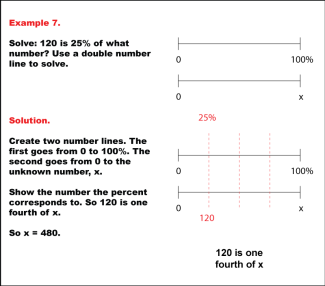
|
Math Example: Percents with Double Number Lines: Example 7 |
Math Example: Percents with Double Number Lines: Example 7TopicRatios, Proportions, Percents DescriptionThis example illustrates how to determine an unknown value using a double number line when given a part and its corresponding percentage. The image depicts two parallel number lines: one spanning from 0 to 100% and another from 0 to an unknown value x. It visually demonstrates the process of finding x when 120 is 25% of x. |
Ratios and Rates |
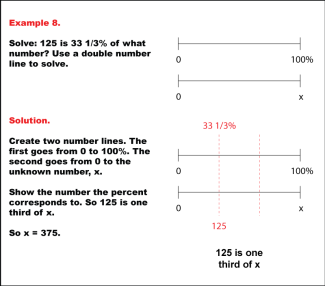
|
Math Example: Percents with Double Number Lines: Example 8 |
Math Example: Percents with Double Number Lines: Example 8TopicRatios, Proportions, Percents DescriptionThis example demonstrates how to find an unknown value using a double number line when given a part and its corresponding percentage, involving a fractional percentage. The image shows two parallel number lines: one ranging from 0 to 100% and another from 0 to an unknown value x. It visually illustrates the process of determining x when 125 is 33 1/3% of x. |
Ratios and Rates |
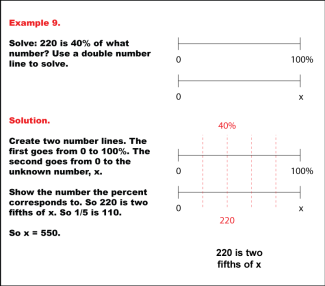
|
Math Example: Percents with Double Number Lines: Example 9 |
Math Example: Percents with Double Number Lines: Example 9TopicRatios, Proportions, Percents DescriptionThis example illustrates how to solve for an unknown value using a double number line when given a part and its corresponding percentage. The image shows two horizontal number lines: the top line ranges from 0 to 100%, and the bottom line ranges from 0 to an unknown number x. The 40% mark on the top line aligns with 220 on the bottom line, visually demonstrating the process of finding x when 220 is 40% of x. |
Ratios and Rates |
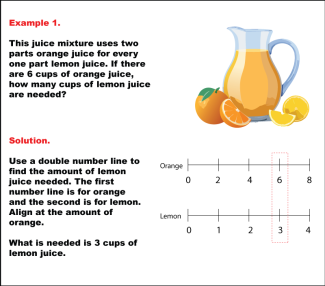
|
Math Example: Ratios with Double Number Lines: Example 1 |
Math Example: Ratios with Double Number Lines: Example 1TopicRatios DescriptionThis example demonstrates the use of double number lines to solve a ratio problem involving orange and lemon juice. The juice mixture uses a ratio of 2 parts orange juice to 1 part lemon juice. Given 6 cups of orange juice, students are asked to determine the amount of lemon juice needed. The solution involves aligning the double number lines at the amount of orange juice and reading the corresponding amount of lemon juice, which is 3 cups. |
Ratios and Rates |
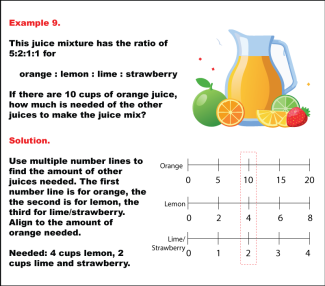
|
Math Example: Ratios with Double Number Lines: Example 10 |
Math Example: Ratios with Double Number Lines: Example 10TopicRatios DescriptionThis example introduces a four-part ratio of 5:2:1:1 for orange, lemon, lime, and strawberry juice. Given 10 cups of orange juice, students need to determine the amounts of lemon, lime, and strawberry juice required. The solution shows that 4 cups of lemon juice and 2 cups each of lime and strawberry juice are needed to maintain the ratio. |
Ratios and Rates |
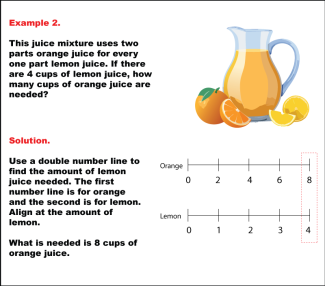
|
Math Example: Ratios with Double Number Lines: Example 2 |
Math Example: Ratios with Double Number Lines: Example 2TopicRatios DescriptionThis example builds upon the previous one, using the same ratio of 2 parts orange juice to 1 part lemon juice. However, in this case, students are given 4 cups of lemon juice and asked to determine the amount of orange juice needed. The solution involves aligning the double number lines at the amount of lemon juice and reading the corresponding amount of orange juice, which is 8 cups. |
Ratios and Rates |
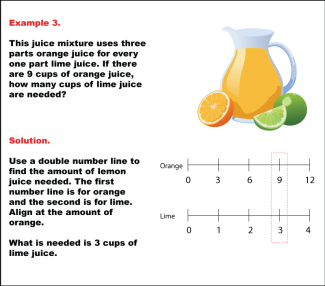
|
Math Example: Ratios with Double Number Lines: Example 3 |
Math Example: Ratios with Double Number Lines: Example 3TopicRatios DescriptionThis example introduces a new ratio of 3 parts orange juice to 1 part lime juice. Students are given 9 cups of orange juice and asked to determine the amount of lime juice needed. The solution involves using a double number line to align at the amount of orange juice and find the corresponding amount of lime juice, which is 3 cups. |
Ratios and Rates |

|
Math Example: Ratios with Double Number Lines: Example 4 |
Math Example: Ratios with Double Number Lines: Example 4TopicRatios DescriptionThis example introduces a more complex ratio of 3 parts orange juice to 2 parts lime juice. Students are given 4 cups of lime juice and asked to determine the amount of orange juice needed. The solution involves using a double number line to align at the amount of lime juice and find the corresponding amount of orange juice, which is 6 cups. |
Ratios and Rates |
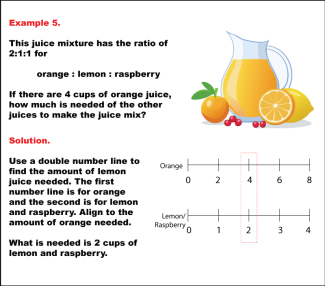
|
Math Example: Ratios with Double Number Lines: Example 5 |
Math Example: Ratios with Double Number Lines: Example 5TopicRatios DescriptionThis example introduces a three-part ratio of 2:1:1 for orange, lemon, and raspberry juice. Given 4 cups of orange juice, students need to determine the amounts of lemon and raspberry juice required. The solution shows that 2 cups each of lemon and raspberry juice are needed to maintain the ratio. |
Ratios and Rates |
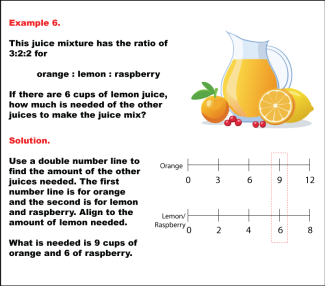
|
Math Example: Ratios with Double Number Lines: Example 6 |
Math Example: Ratios with Double Number Lines: Example 6TopicRatios DescriptionThis example presents a three-part ratio of 3:2:2 for orange, lemon, and raspberry juice. Given 6 cups of lemon juice, students need to determine the amounts of orange and raspberry juice required. The solution shows that 9 cups of orange juice and 6 cups of raspberry juice are needed to maintain the ratio. |
Ratios and Rates |
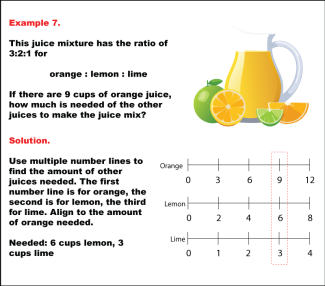
|
Math Example: Ratios with Double Number Lines: Example 7 |
This is part of a series of math examples that show how to solve ratio problems involving double number lines. Note: The download is a PNG file. |
Ratios and Rates |

|
Math Example: Ratios with Double Number Lines: Example 8 |
Math Example: Ratios with Double Number Lines: Example 8TopicRatios DescriptionThis example presents a three-part ratio of 4:3:2 for orange, lemon, and lime juice. Given 4 cups of lime juice, students need to determine the amounts of orange and lemon juice required. The solution shows that 8 cups of orange juice and 6 cups of lemon juice are needed to maintain the ratio. |
Ratios and Rates |
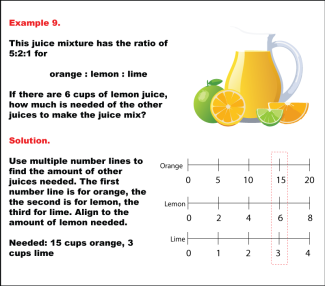
|
Math Example: Ratios with Double Number Lines: Example 9 |
Math Example: Ratios with Double Number Lines: Example 9TopicRatios DescriptionThis example features a three-part ratio of 5:2:1 for orange, lemon, and lime juice. Given 6 cups of lemon juice, students need to determine the amounts of orange and lime juice required. The solution demonstrates that 15 cups of orange juice and 3 cups of lime juice are needed to maintain the ratio. |
Ratios and Rates |
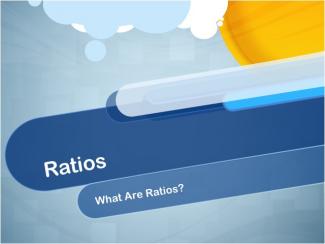
|
Video Tutorial: Ratios, Video 1 |
Video Tutorial: Ratios, Video 1
TopicRatios DescriptionThis video introduces the concept of ratios, which describe relationships between quantities. Key concepts include writing ratios in different forms (e.g., 2:3, 2/3, and 2 to 3) and simplifying ratios. It also covers part-to-part ratios and part-to-whole ratios using examples like sports balls and colored shapes. Applications include categorizing objects and exploring numerical relationships in sets. |
Ratios and Rates |
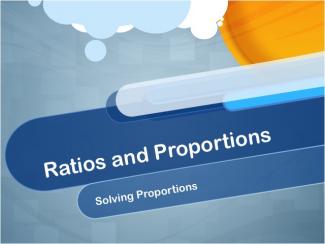
|
Video Tutorial: Ratios, Video 11 |
Video Tutorial: Ratios, Video 11
TopicRatios DescriptionThis video focuses on solving proportions algebraically, converting them into equations to solve real-world problems. Examples include predator-prey ratios, scaling pizza dough recipes, and creating shades of paint. The video demonstrates methods for handling terms in denominators and simplifying ratios to whole numbers. |
Ratios and Rates |
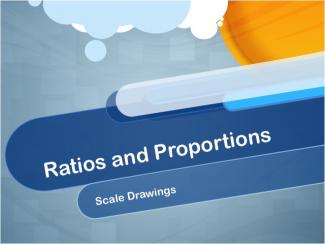
|
Video Tutorial: Ratios, Video 12 |
Video Tutorial: Ratios, Video 12
TopicRatios DescriptionThe video explains how proportions are used to create scale drawings, ensuring geometric figures remain proportional. Examples include finding dimensions in similar triangles, scaling architectural models, and solving geometric problems. The concept of proportional relationships is key to accurate scaling. |
Ratios and Rates |

|
Video Tutorial: Ratios, Video 13 |
Video Tutorial: Ratios, Video 13
TopicRatios DescriptionThis video demonstrates calculating rates from data sets, focusing on patterns like distance-time relationships and wages. Examples include determining car speeds, hourly wages, and unit costs of gasoline. Data tables are used to visualize and compute rates. |
Ratios and Rates |

|
Video Tutorial: Ratios, Video 14 |
Video Tutorial: Ratios, Video 14
TopicRatios DescriptionRates are linked to slopes in linear functions. The video explores calculating rates of change for graphs of speed, savings growth, and loan repayment. It highlights using the slope formula to interpret and solve practical problems. |
Ratios and Rates |
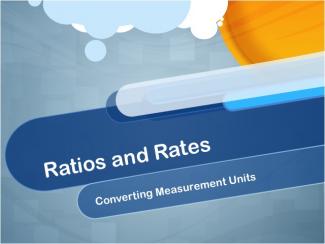
|
Video Tutorial: Ratios, Video 15 |
Video Tutorial: Ratios, Video 15
TopicRatios DescriptionThis video covers converting units using rates, with examples like speed conversion, currency exchange, and calculating seconds in a year. It emphasizes multiplication by conversion rates to transition between units effectively. |
Ratios and Rates |
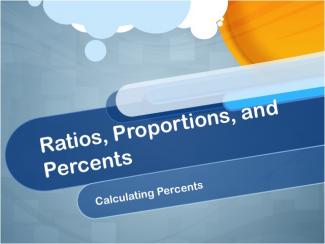
|
Video Tutorial: Ratios, Video 16 |
Video Tutorial: Ratios, Video 16
TopicRatios DescriptionRatios are connected to percentages in this video. Examples include finding percentages of items in collections. It develops a formula for converting part-to-whole ratios into percentages. Relevance to the Topic: This video is a crucial resource for understanding the concept of Ratios. It delves into mathematical foundations by exploring how ratios function in real-life scenarios, such as scaling, comparisons, or visual representations. The mathematical principles demonstrated include proportional reasoning, equivalence, and fraction comparisons. |
Ratios and Rates |

|
Video Tutorial: Ratios, Video 17 |
Video Tutorial: Ratios, Video 17
TopicRatios DescriptionThis video illustrates converting ratios to percents using visual aids like area models and grids. Examples include determining percentages of colored eggs, fruit types, and combinations of colored lights. |
Ratios and Rates |
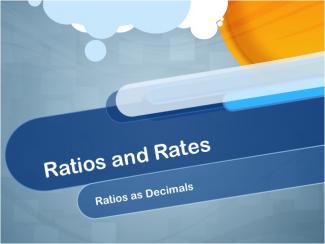
|
Video Tutorial: Ratios, Video 18 |
Video Tutorial: Ratios, Video 18
TopicRatios DescriptionThe video explores working with ratios involving decimals, such as finding unit costs or recycling rates. Scientific notation and multi-step conversions are used to calculate speeds of spacecraft like Voyager I. |
Ratios and Rates |

|
Video Tutorial: Ratios, Video 19 |
Video Tutorial: Ratios, Video 19
TopicRatios DescriptionThe video covers practical applications of ratios for measuring slopes of roofs and ramps. Examples include comparing roof pitches, calculating base lengths of roofs, and determining ramp heights. Ratios provide clarity for gradual slopes. |
Applications of Ratios, Proportions, and Percents and Proportions |
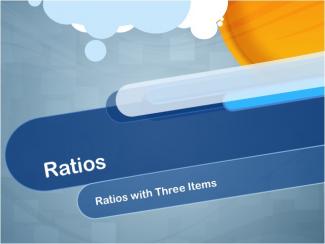
|
Video Tutorial: Ratios, Video 2 |
Video Tutorial: Ratios, Video 2
TopicRatios DescriptionThe video explains ratios involving more than two items, such as 1:3:4, and how they encompass multiple pairwise ratios. Applications include recipes where ingredients are combined in specific proportions. It demonstrates working forward and backward with ratios to identify components or adjust quantities proportionally. |
Ratios and Rates |

|
Video Tutorial: Ratios, Video 20 |
Video Tutorial: Ratios and Rates: Rate of Change
This is part of a collection of video tutorials on the topic of Ratios and Proportions. This series includes a complete overview of ratios, equivalent ratios, rates, unit rates, and proportions. The following section will provide additional background information for the complete series of videos. What Are Ratios?A ratio is the relationship between two or more quantities among a group of items. The purpose of a ratio is find the relationship between two or more items in the collection. Let's look at an example. |
Point-Slope Form and Slope |
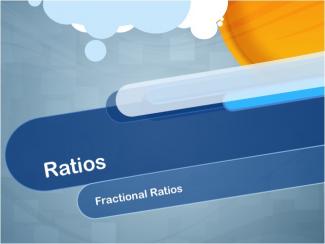
|
Video Tutorial: Ratios, Video 3 |
Video Tutorial: Ratios, Video 3
TopicRatios DescriptionThis video focuses on ratios written with fractions, showing how to convert fractional ratios into whole-number ratios by eliminating denominators. Applications include recipes and ensuring proportions are maintained in measurements. It emphasizes mathematical manipulation to align ratios with practical uses. |
Ratios and Rates |
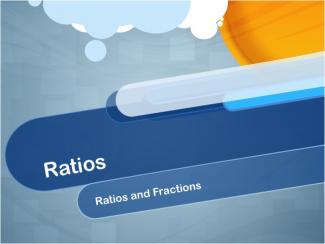
|
Video Tutorial: Ratios, Video 4 |
Video Tutorial: Ratios, Video 4
TopicRatios DescriptionRatios are compared to fractions, emphasizing differences between part-to-part and part-to-whole relationships. Examples include finding fractions of subsets within a collection and modeling classroom demographics. The video highlights deriving fractional equivalents from given ratios. |
Ratios and Rates |
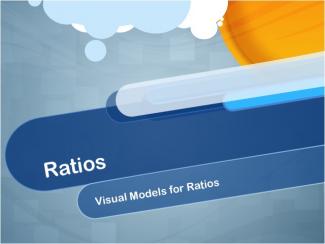
|
Video Tutorial: Ratios, Video 5 |
Video Tutorial: Ratios, Video 5
TopicRatios DescriptionThe video showcases visual representations like tape diagrams, snap cubes, and grids to solve ratio problems. It includes examples such as determining quantities in coin collections and paint mixtures. Applications involve modeling real-world problems using clear, visual methods. |
Ratios and Rates |

|
Video Tutorial: Ratios, Video 6 |
Video Tutorial: Ratios, Video 6
TopicRatios DescriptionNumerical methods for handling ratios are explored, such as double number lines and ratio tables. Examples include tropical punch recipes and fruit stand inventories. These methods simplify complex ratio calculations and are adaptable to various practical scenarios. |
Ratios and Rates |
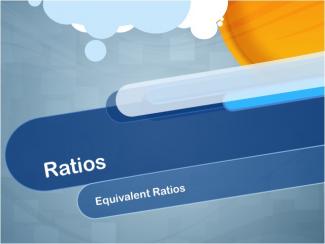
|
Video Tutorial: Ratios, Video 7 |
Video Tutorial: Ratios, Video 7
TopicRatios DescriptionThis video explains generating and comparing equivalent ratios. Examples include simplifying fractions, determining similarity in geometric shapes, and integrating multiple ratios into a comprehensive ratio. Applications extend to geometry and proportional reasoning. |
Ratios and Rates |

|
Video Tutorial: Ratios, Video 8 |
Video Tutorial: Ratios, Video 8
TopicRatios DescriptionThis video introduces rates, a type of ratio comparing different units, such as distance over time (speed) or dollars per hour (wage). Examples demonstrate calculating rates and converting units. Applications include measuring efficiency and performing unit conversions. |
Ratios and Rates |

|
Video Tutorial: Ratios, Video 9 |
Video Tutorial: Ratios, Video 9
TopicRatios DescriptionThe video focuses on unit rates, where the denominator equals one. It includes practical examples like finding the cost per pound of bananas or determining hourly wages. Applications extend to conversions and scaling calculations for various real-world tasks. |
Ratios and Rates |

|
Video Tutorial: Ratios, Video 10 |
Video Tutorial: Ratios, Video 10
TopicRatios DescriptionProportions are explained as equivalent ratios used to solve real-world problems. Examples include matching juice mixtures and adjusting recipes. The video uses ratio tables and number lines to scale ratios proportionally in practical applications. |
Ratios and Rates |